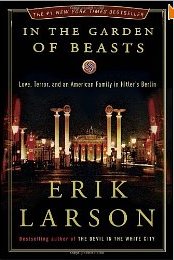Book Review: In the Garden of Beasts by Erik Larson
 Several years ago, I discovered Erik Larson’s engrossing book Eric’s Storm about the 1900 hurricane in Galveston, Texas. When I read his The Devil in the White City: Murder, Magic, and Madness at the Fair That Changed America (which weds the 1893 World’s Fair and serial killer H.H. Holmes), I was hooked.
Several years ago, I discovered Erik Larson’s engrossing book Eric’s Storm about the 1900 hurricane in Galveston, Texas. When I read his The Devil in the White City: Murder, Magic, and Madness at the Fair That Changed America (which weds the 1893 World’s Fair and serial killer H.H. Holmes), I was hooked.
 So it was with great expectations that I recently read his latest book, In the Garden of Beasts: Love, Terror, and an American Family in Hitler’s Berlin. Once again, Larson didn’t disappoint. Since college, where I minored in history, I’ve always loved books that wed history with suspense. Perhaps that’s why history has always played a major role in the suspense novels I like to write.
So it was with great expectations that I recently read his latest book, In the Garden of Beasts: Love, Terror, and an American Family in Hitler’s Berlin. Once again, Larson didn’t disappoint. Since college, where I minored in history, I’ve always loved books that wed history with suspense. Perhaps that’s why history has always played a major role in the suspense novels I like to write.
If you think history is boring, you’ve never read Larson, who is a master at writing engrossing historical suspense. What adds to the intrigue is that his novels are true. Every line of dialogue in his books, which often read more like novels than history books, comes from diaries and other authentic documents, which he meticulously researches.
What the Book Is About
In the Garden of Beasts is about William Dodd, a history professor who agrees to become America’s first ambassador to Germany in 1933 and moves to Berlin with his wife and two children. The drama is mainly about William, who struggles to meet the obligations of his role (to which he seems ill suited), and his loose daughter, Martha, who, dazzled by German high society, quickly dives into one affair after another. But not with just anyone, as you’ll learn.
Thankfully, Larson spares us from the graphic details of Martha’s lifestyle (this is no racy romance novel, though one letter excerpt provided more than this reader cared to know). After all, the book’s focus is not so much about her affairs as about the people with whom she had affairs. Mainly, Larson provides a chilling glimpse of what Germany must have been like for an American family transplanted to Berlin during the rise of Adolf Hitler and his Third Reich.
The sinister title of the book comes from the meaning of the word Tiergarten, which at the time was Berlin’s version of New York City’s Central Park. The beauty and splendor of the park, which was indeed magnificent in its day, provided a deceptive cover for what was really happening in 1933 Berlin. Already Hitler’s key players were beginning step-by-step plans to seize absolute power and bring incremental oppression to the Jewish people.
We see this gradual decline to horror through the eyewitness reports of Ambassador Dodd, thanks to his meticulous diary and correspondence, and Martha’s many letters due to her romantic entanglements with high-profile members of the SS and the Gestapo. Later, she even becomes a Russian spy. Gradually, as the book progresses and Hitler rises in power, both William and Martha, at first deceived by the glamour of “New Germany,” begin to see the terrible truth of where the country is headed.
When William communicates to the United States his growing concerns about the Nazi agenda and the oppression of the Jews, dreading the horror yet to unfold, State Department officials repeatedly dismiss his warnings, suppress the information from reaching American readers, and marginalize his role.
The book culminates in a single night of horror, later called “The Night of Long Knives,” when Hitler, through his henchmen, purges Germany of the many people (some statistics report as many as hundreds) who threatened his rise to power. Yes, this was outright murder; there was no judge or jury, and victims were often lined up against a wall and shot with a machine gun.
The governmental purge was a startling unveiling of Hitler’s drive for absolute power through violence. Given his bloodthirsty bent, that this was merely a dry run and only a prelude to greater horror should have come as no surprise.
My Takeaway Value
I thought the book was fascinating for several reasons. First, I’ve always been fascinated with Holocaust survival stories, and this book provides great back story to that profound tragedy. Evil rarely happens overnight; it comes in baby steps. This book is exhibit A.
Second, I have an as-yet-unpublished young adult novel, Part the Waters, which is based on the true story of an American family trapped in Hitler-controlled Germany. During my research for that novel, I faced a few challenges, mainly finding sources that described what daily German life must have been like, especially as visitors from the United States would have seen it. Larson’s book is a great resource for my research.
Second, I’ve always wondered why no one realized where Hitler was going with his agenda. Wasn’t it obvious? Hindsight is indeed twenty-twenty. Though Hitler, of course, had radical views, it wasn’t obvious at the time that his desire for power would culminate in such bloodshed. Though the early days of his regime exhibited many disturbing signs, no one really knew how far he would go. Larson does an excellent job showing Hitler’s gradual ascent to power and revealing how benign he appeared at the beginning, before people understood his true agenda.
Several facts surprised me.
- Even as early as 1933, Hitler had a public agenda to oppress the Jews. I always thought the mistreatment didn’t kick in until close to the outbreak of war in 1939. I was wrong.
- Anti-Semitism was also pretty common in the United States at the time.
- US newspapers were already publishing news about the Nazi mistreatment of the Jews. Americans were in the know, as far as Hitler’s dislike of the Jewish people.
- United States officials knew a lot about the dangerous direction of the Nazis, yet we waited so long to get involved. Of course, no one could have predicted with certainty the millions of exterminations to come.
- Gestapo and SS officers frequently attacked US tourists. who ignorantly refrained from returning the Hitler salute or failed to give full attention to a street parade of Nazi officers. In one case, a woman from the United States was beaten so badly that she lost her baby and could never conceive again. This violent targeting of American citizens was not a rare occurrence. Ambassador Dodd confronted Hitler personally about the violence, and Hitler promised change. But reality told another story.
This book is a fascinating and engrossing read. If you’ve ever wondered what Hitler’s incremental (and chilling) rise to power must have looked like to those who watched it happen and felt powerless to stop it, this is the book. I highly recommend it.










I’ve read Larson’s “White City,” and I think you’ve convinced me to try this one.
Nothing else he has done is quite as good as “White City,” but I think you’ll really it. I did. Thanks, Glynn.